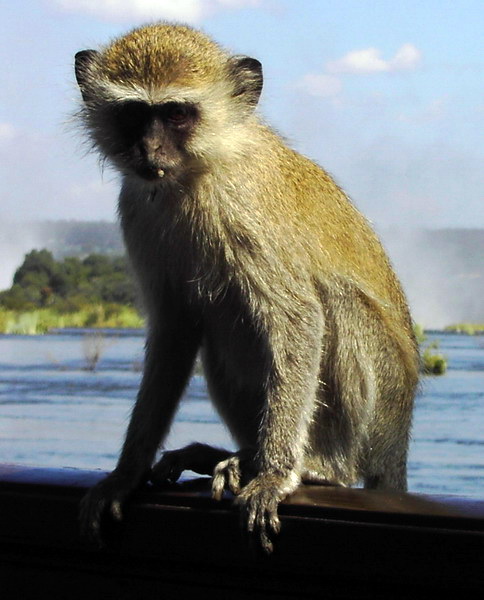Malbrouck
From Wikipedia, the free encyclopedia
[Photo] Malbrouck (Chlorocebus cynosuros) by Hans Hillewaert. Victoria Falls, Livingstone, Zambia, May 2005.
The Malbrouck (Chlorocebus cynosuros) is an East African arboreal primate belonging to the genus of green monkeys (Chlorocebus). It is one of the most common primates of Africa. The species is sometimes classified as a subspecies of the Vervet Monkey (Chlorocebus pygerythrus), or placed in one species with other green monkeys, Chlorocebus aethiops.
Physical characteristics
The Malbrouck is a slim, agile primate with long limbs and a long tail. The fur is grayish brown to gray. The breast and underparts are white, as well as the cheeks and eyebrows, which surround the bald black head. The eyes are brown. The genitals are brightly colored; the scrotum of the male is blue, the penis is red. Males are about twenty percent larger than females.
Distribution and habitat
The Malbrouck lives in a wide variety of habitats, ranging from forests and miombo to bushland and savannas. It is especially common in river forests. The species is found in virtually all of eastern Africa; from the Great Rift Valley to the Atlantic coast and the Horn of Africa.
Behavior
The Malbrouck is a diurnal animal that lives in large groups, consisting of six to more than 50 animals. The number of males and females is usually about the same. Each group has its own territory, the size of which depends on the amount of available food. The Malbrouck has a wide range of sounds and gestures it can use to communicate with other members of a group.
Food
The diet of this omnivorous species consists of fruit, seeds, flowers, gum, invertebrates, eggs, chicks and lizards. Vegetable food forms the largest part of the diet in most areas.
http://en.wikipedia.org/wiki/Malbrouck
| The text in this page is based on the copyrighted Wikipedia article shown in above URL. It is used under the GNU Free Documentation License. You may redistribute it, verbatim or modified, providing that you comply with the terms of the GFDL. |
|

